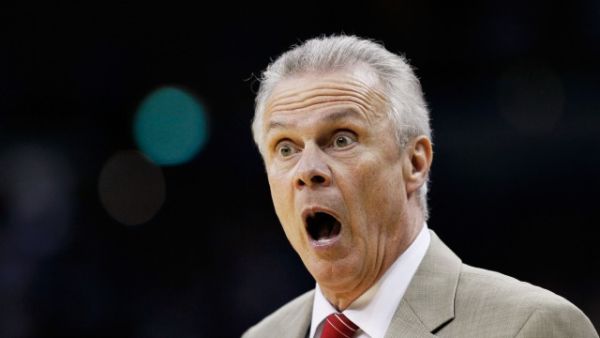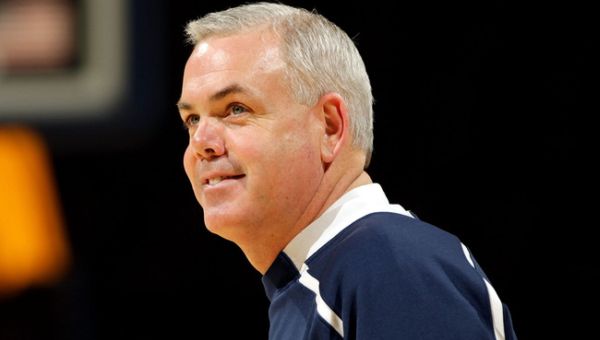30-Second Shot Clock Most Likely to Impact Wisconsin & Virginia
Posted by William Ezekowitz on November 13th, 2015As the 2015-16 college basketball season tips off this afternoon and evening, fans will notice that the shot clock in arenas all across the country has been shortened from 35 to 30 seconds. The change, which was first implemented in NIT, CBI and CIT last year, has been ostensibly made to increase scoring and excitement across the sport. However, the shorter clock will also effectively change the way teams play the game. Success has often been found in extremes in tempo in college basketball (see: the run-and-gun offense of BYU, or the patient efficiency of Wisconsin), and a shorter shot clock will absolutely have an impact on traditional powerhouses’ styles of play and efficacy.

Bo Ryan’s crew was the most efficient offense ever recorded last season. With five less seconds to work with now, will Ryan have to slightly tweak what he preaches? (Getty)
First, let’s look at the data from last season’s NIT, CBI and CIT. Ken Pomeroy ran the numbers on these games and concluded that games with the shorter shot clock averaged about 2.4 more points than in the regular season (with the normal clock). This rise in scoring is because teams added about two more possessions per game using the shorter clock. Working backwards, this means that possessions lasted a little under 18 seconds, as opposed to the norm of 18.4 from last season. Even though this data set is a bit limited in that it is very small (only 75 games) and that it leaves out both very good teams and very bad teams, the general trends exhibited there will probably hold true for the upcoming regular season.
What we don’t have great data for, though, is specific team effects. College basketball teams can often find success by controlling tempo (i.e., possession length) in extreme ways. For example, BYU, Iowa State, North Carolina, Arkansas and Northwestern State turned top 10 tempos last season into extremely efficient and effective offenses. It’s a little more messy than a quick tempo turning into offensive efficiency (shooting early is nice, but you still need to be good at making those shots for it to work), but on the whole, a fast half-court offense has led many teams to offensive success. The change in the shot clock should not bother those teams. If BYU is taking its shots after 14 seconds on most possessions, does Dave Rose really care if the shot clock has 21 or 16 seconds still remaining? In fact, if a team like his can retain its efficiency while others cannot, it stands to gain an advantage from the rule change.
That advantage may really exist because things get a lot murkier on the other end of the spectrum. Northern Iowa, Wisconsin, Virginia and Utah relied on glacial offensive paces last season to gain inclusion among the 25 most efficient offenses. Over the years, teams like Miami, Baylor and Notre Dame have also often parlayed slow paces into offensive success. Granted, there is a fine line between being patient and being unable to manufacture a good shot; in fact, of the 20 slowest offensive teams last year, only five ranked among the top 100 offenses in terms of efficiency. But what is a product of ineptitude for some is a strategy for the offensively capable, like, for example, Wisconsin and Virginia. The logic behind such a strategy is sound if your team can pull it off: take your time, run the offense and wait for the right shot to come.

On the other end of the spectrum, Dave Rose and BYU are consistently one of the fastest teams in the country. Will the Cougars’ advantage be slightly diminished with the shorter clock? (Getty)
But now the shot clock is shorter. With 30 seconds instead of 35 to shoot, Virginia probably cannot afford to take as much as 21.1 seconds to get off an average shot, as the Cavaliers did last season. If they want to use the same proportion of this season’s shot clock, Virginia will need to get that shot up a full two seconds earlier. This doesn’t seem like much in a vacuum, but over the course of the season, it could easily result in significantly more rushed and inefficient shots.
To take another example, Wisconsin was the most efficient offense ever recorded in the KenPom era a year ago, but it was also the second slowest in the country. Bo Ryan seems to have found unprecedented success by holding onto the ball and forcing other teams to play his style. But, much like Virginia, Wisconsin won’t be able to hold onto the ball quite as long this year. Can the Badgers maintain their incredible offensive efficiency when forced to release the ball a little bit earlier? For both of these teams — and really all teams that purposefully plod on offense — some sort of philosophical change on offense might be a must. Refusal to evolve in kind could bring teams a serious risk of seeing their efficiency plummet with too many forced shots as the shot clock moves quickly toward zero.
The fundamental question, then, is what is going to happen to efficiency? We would think that teams holding the ball more would suffer — Virginia and Wisconsin predicate their offense on taking their proper amount of time to find the right shot. But if the Cavaliers want to reach that elusive Final Four this year, and if Wisconsin wants to return there for the third April in a row, they will have no choice but to find the right shot a little sooner.










































No shock what-so-ever, Wisconsin and Virginia seem to have adjusted just fine. As was evident to most, well-coached, disciplined teams that play to the rules had no difficulty dealing with a slight tweak to those rules. And on the other side of the ball, sound defensive teams likely benefited from the rule change. Undisciplined offenses – whether high or low temp – were the ones that struggled to adjust.